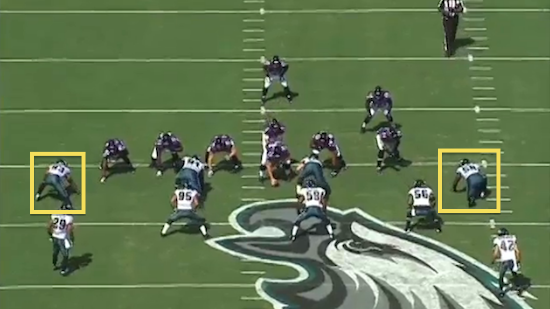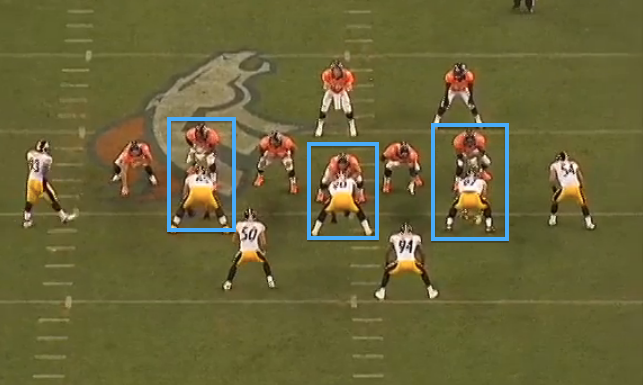All-22: How the Eagles Are Moving Towards a 3-4
Chip Kelly knows what he wants his defense to look like – eventually.
He’s just not sure how quickly he’ll be able to get there.
“I think there’s a versatility in the 3-4 defense that you like, but, again, I think when Billy [Davis] said it, we’re going from a Wide-9 to a 3-4,” Kelly said. “When do we get to a 3-4, I don’t know. We may have to stop at being a one‑gap over and under defense depending upon still making an evaluation of what our guys can do. We haven’t been drafting for this [before 2013] and converting some of those defensive ends to see what they can do. Our job is to do a great job of figuring out what they do best and then playing to those strengths.”
We’ll start to get a better idea of where the defense stands Friday night when the Eagles take on the Patriots. But for now, it’s worth reviewing their options to get a better idea of where they might end up.
Let’s start with what they’re not going to run: the Wide-9 4-3, as Davis refers to it.
This is what Eagles fans saw the last two years. The benefits? With the right pieces, the defense can generate pressure from the front four without sacrificing additional bodies.
The downside? It can be predictable. The Eagles rushed four on 77.8 percent of their snaps last year, tops in the NFL according to the Football Outsiders Almanac. Opposing offenses knew where the pressure was coming from and rarely had to worry about blitzes.
Meanwhile, linebackers had to constantly deal with offensive linemen in their faces, and safeties had run responsibilities, which left them vulnerable to play-action.
“Any time you ask the secondary to be primary B or A gap run defenders, you’re just asking for trouble on play-action and deep balls,” Davis said. “I hate to talk too much about last season not being here, but just all the transition and all the different communications that happened, I don’t know how you fight through that and play good, I really don’t.”
It’s obvious Davis is no fan of the Wide-9 and is committed to making sure the 2013 defense looks nothing like the unit that took the field the previous two years.
THE 4-3 UNDER
We wrote about the 4-3 under at length when Davis was hired. He has experience with the under front from his time with the Arizona Cardinals. Below is an All-22 shot of the Texans in the 4-3 under, but the positions are labeled with current Eagles personnel to show how the pieces fit.
It’s a 3-4 look with three down linemen (Cedric Thornton, Isaac Sopoaga and Fletcher Cox in the photo), but the weak-side outside linebacker (Trent Cole) is a pass-rush specialist who rarely drops back into coverage.
“The stand-up is more confusion for the offense – is that guy dropping or rushing?” Davis said. “When his hand’s down, most of the time, he’s probably [rushing]. And it affects protections and everything else.”
When center Jason Kelce sets the protection for the offense, the first thing he identifies is whether the defense is showing three down linemen or four. I asked offensive line coach Jeff Stoutland if having that fourth rusher stand up makes setting the protection more difficult.
“Yeah, absolutely,” he said. “There’s no question. Whenever you ask your offensive line to make another change in the communication, somebody might not get it. It’s like the secondary. It’s like when you change formations and you shift, then you motion and they’re making calls back and forth to each other, all one guy has to do is miss the call and it’s a touchdown.”
Also take note of where the defensive linemen are set up. They are not head-up on the offensive linemen. They are in gaps. The 5-technique (Thornton) is between the right tackle and the tight end. The nose tackle (Sopoaga) is between the center and the right guard. And the 3-technique (Cox) is between the left guard and the left tackle.
The 2013 Eagles Almanac contains a detailed explanation on how the 4-3 under could fit the Eagles’ personnel. Connor Barwin has been playing LOLB during practices and can be used in a variety roles – both as a pass-rusher and in coverage (All-22 here). Cox should get his fair share of one-on-one matchups as the 3-technique. Sopoaga and Thornton have to do the dirty work and take on double teams.
You’ll notice Brandon Graham is missing in the diagram. He’s been practicing behind Barwin at LOLB, but could very well end up rotating with (or replacing) Cole at the other spot.
THE TWO-GAP 3-4
This is what the Eagles are moving towards. In a Yahoo Sports column back in March, Greg Cosell provided a clear explanation of what a two-gap 3-4 entails:
The supposition with 3-4 fronts has always been it’s a “2-gap” scheme, with the two defensive ends aligned directly over the offensive tackles, and the nose tackle head up on the center. The term “2-gap” derives from their responsibilities as run defenders. All three of those defensive linemen are responsible for two gaps along the line of scrimmage. They do not penetrate through a single gap at the snap of the ball; rather, they stalemate the blocker in front of them, at the same time reading where the back is going. They are accountable for the gap to each side of their respective offensive lineman. Once the back declares, the defensive linemen ideally shed their blockers and get to the ball.
Or as Chris Brown wrote in The Essential Smart Football, “While a one-gap player attacks gaps, a two-gap player attacks people.”
Cosell notes that most teams have moved away from the two-gap 3-4, but one team that still employs it is the Pittsburgh Steelers. Take a look at the setup from a game last year:
The key is where the nose tackle and two ends are lined up. Unlike the one-gap 4-3 under that we showed above, the defensive linemen are head-up on the two offensive tackles and the center.
As we’ve written about at length, Davis was influenced greatly by his early days as a defensive quality control coach with the Steelers, working under Bill Cowher, Dom Capers and Dick LeBeau. Davis even showed Eagles defensive linemen Steelers film during the spring.
“We were watching film on the Steelers to really just watch how those guys control the line of scrimmage… how the defensive line just controls the game,” said rookie Bennie Logan.
Added Davis: “If you want to teach a technique, the best way is to show somebody doing it correctly. Well, we don’t have any padded film of that so we use other teams in the league that play similar techniques. And I’ve got a heavy background with the Steelers and a couple coaches so we just chose to use some of those.”
During the spring, I was looking for clues about what kind of defense the Eagles were going to run, and Connor Barwin helped me out. Barwin comes from the Texans where he played in Wade Phillips’ one-gap scheme. But he said the Eagles’ front would be different. How so?
“Let me ask you,” he replied. “What are the differences between the Dick LeBeau 3-4 and the Wade Phillips 3-4?”
LeBeau’s is a two-gap front, while Phillips’ is one-gap?
“Then that should answer the question for you,” he said.
“From watching defenses and watching the Steelers, being in the AFC and playing them, knowing what they do, seeing them play other teams that we prepared for, there’s definitely some similarities, which you guys all know,” Barwin added. “That was where Billy first started on defense, so obviously there will be similarities.”
In addition to the two-gap 3-4 being part of Davis’ background, it seems to be Kelly’s preference also. Remember how Kelly drafted several players who performed well against his Oregon teams? Perhaps the same theory applies to scheme. One team last year held the Ducks to fewer than 35 points, and that was Stanford, which handed Oregon its only loss of the season (17-14).
What kind of defense does the Cardinal run? A two-gap 3-4. Greg A. Bedard of TheMMQB.com wrote a terrific piece recently on Stanford’s defense:
The two biggest adjustments being made in professional football will ramp up once the pads are strapped on in training camp. Teams that favor a 4-3 single-gap defense are going to need a backup plan, meaning they’ll have to become a 3-4 team against the read-option. And all edge defenders will need to be retrained, if not brainwashed, on how to play their position.
The best defense to stop a traditional running offense is the 3-4. With three down linemen responsible for the interior and two outside linebackers covering the edges, all the gaps are covered. The two inside linebackers react to the flow of a play and help form a wall, meaning a properly defensed running play should yield no room for a back to break through the line of scrimmage.
As offenses around the league install more of the read-option, defenses are tasked with figuring out ways to stop it. And if more college ideas make their way to the NFL, the Eagles are confident they will have answers. While Davis has twice been a defensive coordinator in the NFL and most recently spent time directing the Cleveland Browns’ linebackers, all seven coaches working under him are from the college ranks.
“The bag of tricks is coming from this staff,” he said earlier this offseason. “Because this staff, all the coordinators on this staff, have been facing that [the read option] for a long time. And as we talk and go through it, it’s something I haven’t seen a lot.
“I remember last year in Cleveland, we had to spend a lot of time watching Washington and figuring out how we were going to adapt Coach [Dick] Jauron’s defense to stop that. Well, the guys that are in our defensive staff room right now, they’ve solved that problem a hundred times.”
As both Kelly and Davis have implied, the shift could be gradual. And the truth is, scheme will depend on game-plan and opponent. The Eagles play Robert Griffin III in Week 1, but come right back with a matchup against a classic drop-back passer in Philip Rivers in Week 2.
While the Eagles have overhauled their roster, many of the pieces up front on defense remain the same. When they open the season, it’s possible that the only two new players in the front seven will be Barwin and Sopoaga.
Others will be asked to adjust to new roles. Most notably, that means Cole and Graham playing as outside linebackers. Their ability to make the switch, along with the new responsibilities of the linemen up front will determine how far Davis moves the defense towards a true 3-4 in Year 1.
Follow Sheil Kapadia on Twitter and e-mail him at skapadia@phillymag.com.
Become a fan of Birds 24/7 on Facebook.

